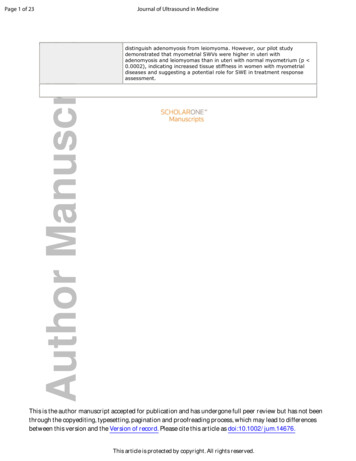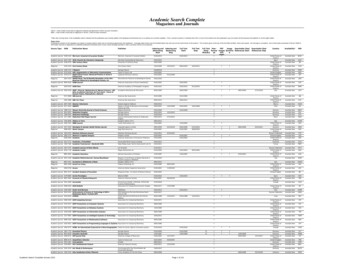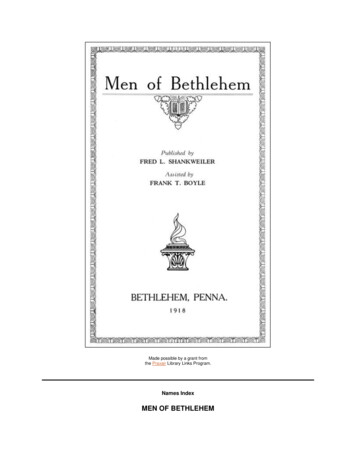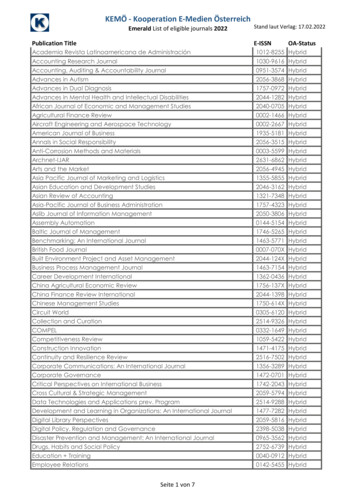
Transcription
Journal of Ultrasound in MedicineAuthor ManuscriptPage 1 of 23distinguish adenomyosis from leiomyoma. However, our pilot studydemonstrated that myometrial SWVs were higher in uteri withadenomyosis and leiomyomas than in uteri with normal myometrium (p 0.0002), indicating increased tissue stiffness in women with myometrialdiseases and suggesting a potential role for SWE in treatment responseassessment.This is the author manuscript accepted for publication and has undergone full peer review but has not beenthrough the copyediting, typesetting, pagination and proofreading process, which may lead to differencesbetween this version and the Version of record. Please cite this article as doi:10.1002/jum.14676.This article is protected by copyright. All rights reserved.
Author ManuscriptJournal of Ultrasound in MedicineOriginal researchTransvaginal Ultrasound (TVUS) Shear Wave Elastography (SWE) for the Evaluation of Benign UterinePathologies: A Prospective Pilot StudyMan Zhang, MD PhD1,2Ashish P Wasnik, MD1William R Masch, MD1Jonathan M. Rubin, MD PhD1Ruth C Carlos, MD MS1Elisabeth H Quint, MD3Katherine E Maturen, MD MS1,31.Department of Radiology, University of Michigan1500 E. Medical Center DriveAnn Arbor, MI 481092.Department of Radiology, University of Washington1959 NE Pacific StreetSeattle, WA 981953.Department of Obstetrics and Gynecology, University of Michigan1500 E. Medical Center DriveAnn Arbor, MI 48109Corresponding author:Man Zhang, MD PhDDepartment of RadiologyUniversity of Washington Medical CenterBox No. 357115, Seattle, WA 98195Telephone: 206-598-0024Email: maggiez1@uw.eduRunning title: Shear Wave Elastography of Benign Uterine Diseases1This article is protected by copyright. All rights reserved.Page 2 of 23
Journal of Ultrasound in MedicineAuthor ManuscriptPage 3 of 23Transvaginal Ultrasound (TVUS) Shear Wave Elastography (SWE) for the Evaluation of UterineAdenomyosis and Leiomyomas: A Prospective Pilot StudyAbstractObjectives: This study evaluated diagnostic performance of transvaginal ultrasound (TVUS) shear waveelastography (SWE) for evaluating benign uterine adenomyosis and leiomyomas. Methods: IRB approvalwas obtained for prospective enrollment of 34 premenopausal women with pelvic pain and/or bleedingbetween January 2015-June 2016. TVUS SWE was performed with regions of interest in multiple uterinesegments and shear wave velocities (SWVs) were recorded. Reference pelvic MR exams wereperformed and reviewed without access to the US results. Results: Continuous variables were analyzedusing means, t-tests and ANOVA. MR revealed adenomyosis in 6 women (12 uterine segments), andleiomyomas in 12 women (28 segments). On a per patient basis, mean SWV in 16 women with noadenomyosis or leiomyoma was 4.3 1.7 m/s, compared with 5.7 2.3 m/s in 18 women with MRdiagnosis of myometrial pathology (p 0.0002, 95% CI -2.2, -0.6). On a per segment basis, SWV innormal myometrium was 4.8 1.9 m/s, compared with 4.9 2.5 m/s in adenomyosis and 5.6 2.5 m/sin leiomyoma (p 0.34 by one-way ANOVA). In pairwise comparison, SWV for adenomyosis andleiomyoma did not differ significantly (p 0.40). Conclusions: TVUS SWE did not distinguish adenomyosisfrom leiomyoma. However, our pilot study demonstrated that myometrial SWVs were higher in uteriwith adenomyosis and leiomyomas than in uteri with normal myometrium (p 0.0002), indicatingincreased tissue stiffness in women with myometrial diseases and suggesting a potential role for SWE intreatment response assessment.Key words: uterine leiomyoma; adenomyosis; shear wave elastography; transvaginal ultrasound2This article is protected by copyright. All rights reserved.
Author ManuscriptJournal of Ultrasound in MedicineIntroductionUterine adenomyosis, abnormal growth of endometrial tissue into the myometrium, is acommon incidental finding in hysterectomy specimens. Estimates of true prevalence range from 18-66%in hysterectomy and biopsy specimens in the recent literature.1 The primary symptoms of adenomyosisare chronic pelvic pain and abnormal uterine bleeding, but there is also an association with subfertility.2Adenomyosis is under-diagnosed: in one recent study, fewer than a quarter of patients had a correctpreoperative diagnosis, with a frequent misdiagnosis as leiomyoma by ultrasound.3 The prospectivediagnosis of adenomyosis is clinically significant because it may alter treatment decisions.B-mode transvaginal ultrasound (TVUS) and pelvic MR have been evaluated for detection ofadenomyosis, with sensitivity of approximately 74% and positive predictive value (PPV) of 68% for TVUSand sensitivity of 81% and PPV 76% for MR in reader studies with attention to this diagnosis.4 However,in everyday practice the prospective diagnosis of adenomyosis by conventional ultrasound remainsuncommon.Sonoelastography, including static strain elastography and dynamic shear wave elastography(SWE), has been extensively studied in liver fibrosis 5, 6 7 thyroid 8 and breast neoplasms 9, 10 in the pastdecade; in all instances the pathological condition tends to be firmer than normal visceral parenchyma.In contrast, obstetric and gynecologic implementations are underexplored with most of the studiesusing strain elastography, a subjective method 11. SWE is an objective quantitative ultrasoundelastography technique, which can depict the stiffness of anatomic structures, to aid in their detectionand characterization. SWE uses a push pulse, often referred to as acoustic radiation force, from theimaging transducer to generate shear waves in soft tissues. Shear waves propagate perpendicular to thedirection of the push pulse and their velocity can be tracked by ultrasound, directly assessing tissuestiffness. As smooth muscle tumors, leiomyomas tend to be firm and rubbery on gross examination.Adenomyosis is glandular tissue, more similar to soft endometrium than firm myometrium.3This article is protected by copyright. All rights reserved.Page 4 of 23
Journal of Ultrasound in MedicineAuthor ManuscriptPage 5 of 23The application of elastography to the uterus has been tested in vitro in a study of unfixedhysterectomy specimens 12, distinguishing between leiomyomas (firmer than myometrium) andendometrial polyps (softer than myometrium) and illustrating a single case of adenomyosis (similar toendometrium, softer than myometrium). TVUS elastography probes enable in vivo evaluation of thisconcept. Early reports have focused on endometrium 13, 14 with distinction between normal andhypertrophic endometrium (relatively soft) versus polyps (slightly firmer). Assessment of cervicalripening in labor 15, which is critical to predict the likelihood of success in labor induction, has also beenexplored. Sonoelastographic characterization of benign myometrial conditions is ongoing. Severalrecent studies use strain elastography to diagnose adenomyosis and uterine leiomyomas 16-18. Only onestudy in the literature investigates SWE of adenomyosis 19. Thus, the use of in vivo SWE for myometrialassessment is truly a novel application of an emerging technology. Therefore, we propose to assess thetest performance of TVUS with SWE to evaluate the marginal diagnostic utility of ultrasoundelastography for benign uterine pathologies, using pelvic MR as the reference standard.Materials and MethodsFrom January 2015 to June 2016, premenopausal women with pelvic pain and/or bleeding andno history of gynecologic malignancy, who provided informed consents, were enrolled in this IRBapproved prospective study. Medical records were reviewed for demographic and clinical information.TVUS was performed on a SuperSonic Aixplorer (SuperSonic, Aix en Provence, France) US machine by aregistered diagnostic medical sonographer with 2 years of SWE experience. A 6-8 MHz transvaginalprobe was used to image the uterus, and representative still and cine greyscale and color Dopplerimages were stored. In SWE mode, 2 or 3 regions of interest (ROIs) ( 0.5 cm in diameter) were placedin each of the following segments, depending on the anatomical location and target tissue thickness, toobtain shear wave velocities (SWVs): anterior and posterior cervix, anterior and posterior myometrium,4This article is protected by copyright. All rights reserved.
Author ManuscriptJournal of Ultrasound in Medicinefundus, and within endometrial stripe, as well as centered within any visualized myometrial orendometrial mass. The size of the ROI was carefully chosen in order to measure adequate softtissue/lesion yet within the confined uterus/lesion. The SWV was measured by the SWE software on theUS machine and shown on the image. The reliability of the measurements was based on the quality ofelasticity color map overlaid on the gray scale image and the standard deviation of each measurement.The measurement was considered invalid if the color pixels in the ROI were scant or the standarddeviation was greater than 30%.Ultrasound images were stored and reviewed using Syngo Dynamics workstations (SiemensHealthineers, Mountain View, CA). US images were reviewed in consensus by a board certifiedabdominal radiologist with 10 years’ experience and a current abdominal imaging fellow. Mean valuesat each uterine anatomic site were calculated when two or more ROIs returned technically adequatevelocities. The SWVs were tabulated.As the reference standard, contrast enhanced pelvic MR exams were performed on a 1.5T GESigna Excite (GE Healthcare, Waukesha, WI) or Philips Ingenia (Philips Healthcare, Andover, MA) scannerusing an anterior body surface coil including the following sequences: three plane localizers, sagittal andshort axis T2-weighted FSE with fat saturation, and pre and post contrast T1-weighted axial SPGRthrough pelvis. Patients received 1 mg glucagon IM and 0.2mL/kg body weight intravenous gadobenatedimeglumine (MultiHance, Bracco Diagnostics, Monroe Twp, NJ). MRI images were stored and reviewedusing McKesson PACS (McKesson Radiology, San Francisco, CA).MR exams were reviewed in consensus by two board certified radiologists with 1 and 7 years’experience after abdominal fellowship training, who were blinded to the ultrasound and clinical findings.The presence, type and location of any uterine pathology were recorded. Adenomyosis was diagnosedwhen the uterine junctional zone thickness exceeded 12 mm on T2WI and/or subendometrial cysts wereidentified in an area of junctional zone irregularity 20. Uterine leiomyomas were diagnosed when focal,5This article is protected by copyright. All rights reserved.Page 6 of 23
Journal of Ultrasound in MedicineAuthor ManuscriptPage 7 of 23well circumscribed masses with low signal on T2WI were identified within or arising from themyometrium21.SWVs were analyzed on a per patient and a per anatomic site basis, recognizing that themultiple measurements within a single uterus are not independent observations. Continuous variableswere analyzed using means, t-tests and ANOVA, and categorical variables were analyzed using counts,frequencies, and percentages. All statistical tests were performed using Microsoft Excel (Microsoft Inc,Redmond WA) or SAS 9.4 (SAS Institute, Cary NC), assuming p 0.05 for statistical significance.Results34 premenopausal women (mean age 36.8 years, range 22-52) were enrolled, with mean timebetween US and MR exams 11 days ( 27, range 0-118). The studies were performed on the same day for25 women, US was performed prior to MR for 4 women, and MR preceded US for 5 women.MR revealed adenomyosis in 6 women involving 12 uterine segments, leiomyoma in 12 womeninvolving 28 segments, and no cervical pathology in any of the 34 women. One woman had bothadenomyosis and leiomyomas at MR imaging. On a per patient basis, mean SWV in combined segmentsof 16 women with no adenomyosis or leiomyoma was 4.3 1.7 m/s (, range 1.8-9.4), compared with 5.7 2.3 m/s (, range 1.7-9.9) in 18 women with MR diagnosis of myometrial pathology (p 0.0002, 95% CIof difference -2.2, -0.6) (Figure 1). Treating each myometrial segment as an independent observation,SWV in normal segments was 4.8 1.9 m/s, compared with 4.9 2.5 m/s in adenomyosis and 5.6 2.5m/s in leiomyoma (p 0.34 by one-way ANOVA) (Figure 2). In pairwise comparison, SWV for adenomyosisand leiomyoma did not differ significantly (p 0.40).Mean cervical stromal SWV was 5.26 m/s ( 1.99, range 2.3-10.0), higher than that of normalmyometrium (p 0.04). Only one patient had endometrial pathology, diagnosed as a polyp on MR,6This article is protected by copyright. All rights reserved.
Author ManuscriptJournal of Ultrasound in Medicinedemonstrating SWV of 3.6 m/s. Representative images in a normal uterine segment, adenomyosis, andleiomyoma are shown in Figures 3-5.DiscussionsOur pilot study demonstrated that myometrial SWVs were higher in the setting of uterinepathologies including adenomyosis and leiomyomas than in normal myometrium (5.7 vs 4.3 m/s,p 0.0002), indicating increased tissue stiffness in women with myometrial diseases. This observation isclinically relevant in several regards. Abnormal contractility and hyperperistalsis, particularly in theinner myometrium or junctional zone, are thought to cause pain and cramping as well as subfertility dueto altered sperm transport in adenomyosis 21, 22. It seems likely that muscular stiffness, contractility, andpropagation of peristaltic waves are related, suggesting an avenue for further research into the utility ofSWE for treatment response assessment. Systemic and intrauterine pharmacologic therapies as well asablative treatments — such as high frequency ultrasound ablation and uterine artery embolization — forboth adenomyosis and leiomyomas are of increasing interest to women who wish to avoid surgery, andin some cases to maintain fertility. Current methods for assessment of disease severity and treatmentresponse, such as measurements of uterine size and junctional zone thickness, are purely morphologic.Results of clinical trials have been difficult to interpret given the poor performance of these imagingendpoints, with some investigators reporting decreased uterine size as a marker of success 23, 24, whileothers reported unchanged uterine size in patients with symptomatic improvement 25. Decreasedjunctional zone thickness is a marker of response in some trials 25, 26, though others noted no differencein the junctional zone: myometrial ratio, suggesting that decreased junctional zone thickness may simplyreflect overall volume loss 23. As such, the field is ripe for a functional imaging endpoint, and withfurther standardization of the technique and large scale validation, we suggest that TVUS SWE hastremendous potential in this regard.7This article is protected by copyright. All rights reserved.Page 8 of 23
Journal of Ultrasound in MedicineAuthor ManuscriptPage 9 of 23In contrast to the assumption that tissues with pathological differences may have measurableelasticity difference, TVUS SWE did not successfully distinguish adenomyosis from leiomyoma, whichmay relate to a few factors. First, adenomyosis is abnormal growth of glandular tissue into themyometrium. Although glandular tissue itself is soft, local congestion and reactive muscular hypertrophymay be present within the confined myometrium in vivo, resulting in increased stiffness. Second,although we documented diagnostic SWVs in all uterine segments, larger and more globular uteri posedsubjective technical challenges, with multiple attempts required, particularly in the more deeplypositioned posterior myometrium. Besides, the generally accepted assumption is that SWVmeasurements are most reliable when they are made in infinite, homogeneous media. In other words,boundary effects will influence the measured speeds, especially within focal masses. However, clinicalapplications of SWE in confined tissues have been carried out over the last decade 27-29. Third,leiomyomas are often well marginated, whereas adenomyosis is by its nature infiltrative. As such, it ismuch easier to place a discrete ROI on a sonographically evident leiomyoma than on an ill-definedregion of adenomyosis. In further research, it may be valuable to “work backwards” from known areasof abnormality on MRI in order to more readily isolate the SWV in adenomyosis and leiomyomas.Finally, adenomyosis and leiomyomas coexist in up to 57% of women with adenomyosis on pathologicspecimens 30, and in one woman based on MR diagnosis in our study population, and it is possible thatsome ROIs sampled both conditions at once.This is an emerging area of research and results from recent publications regardingsonoelastographic characterization of adenomyosis and uterine leiomyomas are inconsistent thus far. Inseveral strain elastography-based studies 16-18, transvaginal compression was applied on the targeteduterine segments to obtain strain ratios among leiomyoma, normal myometrium and adenomyosis.Their results supported the capability of strain elastography to differentiate adenomyosis fromleiomyomas, although one study showed suboptimal agreement between strain elastography diagnosis8This article is protected by copyright. All rights reserved.
Author ManuscriptJournal of Ultrasound in Medicineof adenomyosis and histology 18. Only one study in the literature used SWE to evaluate adenomyosis 19,with results similar to ours: significantly increased myometrial stiffness in patients with adenomyosis.The abovementioned inconsistency might reflect underlying technical differences in measuring tissuestiffness within a confined organ, which warrants further investigation.This study has several limitations. First, the sample size is relatively small in this pilotinvestigation. Larger studies with controlled acquisition methods including number and interquartilerange (IQR) of SWV measurements will be needed to establish the reliability of this approach and toestablish whether any quantitative threshold separates normal from abnormal uteri. Second, there islack of pathologic correlation, given the absence of any direct indication for surgery in this population.We formalized MRI interpretation and strengthened our standard of reference by using publishedcriteria, defined anatomic segments, and two experienced readers working in consensus. Third, thephase of menses was not controlled during the examination, and hormonal effects on the myometrium,particularly the junctional zone, may have contributed to unrecognized SWV variation.In conclusion, this pilot study demonstrated globally increased myometrial stiffness using shearwave elastography in women with myometrial disorders including adenomyosis and leiomyomas. Ourresult suggests additional directions for inquiry into fibrosis and/or altered muscular contractility as acontributor to chronic symptoms in women with these disorders, and a potential role for elastography intreatment response evaluation.9This article is protected by copyright. All rights reserved.Page 10 of 23
Journal of Ultrasound in MedicineAuthor ManuscriptPage 11 of 23Acknowledgement: This study was completed with financial support from the Association of UniversityRadiologists and General Electric through the AUR-GERRAF fellowship program (K.E.M.). The authorsgratefully acknowledge the efforts of research team members James Pool, LaDonna Austin, and TamaraHarper and ultrasound technologist Annica Johnson.References1.Vercellini P, Vigano P, Somigliana E, Daguati R, Abbiati A, Fedele L. Adenomyosis:epidemiological factors. Best Pract Res Clin Obstet Gynaecol. 2006; 20:465-77.2.Maheshwari A, Gurunath S, Fatima F, Bhattacharya S. Adenomyosis and subfertility: a systematicreview of prevalence, diagnosis, treatment and fertility outcomes. Hum Reprod Update. 2012; 18:37492.3.Taran FA, Wallwiener M, Kabashi D, Rothmund R, Rall K, Kraemer B, et al. Clinical characteristicsindicating adenomyosis at the time of hysterectomy: a retrospective study in 291 patients. Arch GynecolObstet. 2012; 285:1571-6.4.Dueholm M, Lundorf E. Transvaginal ultrasound or MRI for diagnosis of adenomyosis. Curr OpinObstet Gynecol. 2007; 19:505-12.5.Sigrist RMS, Liau J, Kaffas AE, Chammas MC, Willmann JK. Ultrasound Elastography: Review ofTechniques and Clinical Applications. Theranostics. 2017; 7:1303-29.6.Barr RG, Ferraioli G, Palmeri ML, Goodman ZD, Garcia-Tsao G, Rubin J, et al. ElastographyAssessment of Liver Fibrosis: Society of Radiologists in Ultrasound Consensus Conference Statement.Ultrasound Q. 2016; 32:94-107.10This article is protected by copyright. All rights reserved.
Author ManuscriptJournal of Ultrasound in Medicine7.Ferraioli G, Tinelli C, Dal Bello B, Zicchetti M, Filice G, Filice C, et al. Accuracy of real-time shearwave elastography for assessing liver fibrosis in chronic hepatitis C: a pilot study. Hepatology. 2012;56:2125-33.8.Liu Z, Jing H, Han X, Shao H, Sun YX, Wang QC, et al. Shear wave elastography combined with thethyroid imaging reporting and data system for malignancy risk stratification in thyroid nodules.Oncotarget. 2017; 8:43406-16.9.Youk JH, Gweon HM, Son EJ. Shear-wave elastography in breast ultrasonography: the state ofthe art. Ultrasonography. 2017; 36:300-9.10.Cong R, Li J, Wang X. Comparing Performance of Combinations of Shear Wave Elastography andB-Mode Ultrasound in Diagnosing Breast Masses: Is It Influenced by Mass Size? Ultrasound Med Biol.2017; 43:2133-43.11.Swiatkowska-Freund M, Preis K. Cervical elastography during pregnancy: clinical perspectives.Int J Womens Health. 2017; 9:245-54.12.Hobson MA, Kiss MZ, Varghese T, Sommer AM, Kliewer MA, Zagzebski JA, et al. In vitro uterinestrain imaging: preliminary results. J Ultrasound Med. 2007; 26:899-908.13.Neale E, Housden R, Crawford R, Treece G, Sala E, Gee A, et al. A pilot study using transvaginalreal-time ultrasound elastography to evaluate the postmenopausal endometrium. Ultrasound ObstetGynecol. 2011; 38:235-6.14.Preis K, Zielinska K, Swiatkowska-Freund M, Wydra D, Kobierski J. The role of elastography in thedifferential diagnosis of endometrial pathologies--preliminary report. Ginekol Pol. 2011; 82:494-7.15.Molina FS, Gomez LF, Florido J, Padilla MC, Nicolaides KH. Quantification of cervicalelastography: a reproducibility study. Ultrasound Obstet Gynecol. 2012; 39:685-9.16.Tessarolo M, Bonino L, Camanni M, Deltetto F. Elastosonography: a possible new tool fordiagnosis of adenomyosis? Eur Radiol. 2011; 21:1546-52.11This article is protected by copyright. All rights reserved.Page 12 of 23
Journal of Ultrasound in MedicineAuthor ManuscriptPage 13 of 2317.Frank ML, Schafer SD, Mollers M, Falkenberg MK, Braun J, Mollmann U, et al. Importance ofTransvaginal Elastography in the Diagnosis of Uterine Fibroids and Adenomyosis. Ultraschall Med. 2016;37:373-8.18.Stoelinga B, Hehenkamp WJ, Brolmann HA, Huirne JA. Real-time elastography for assessment ofuterine disorders. Ultrasound Obstet Gynecol. 2014; 43:218-26.19.Acar S, Millar E, Mitkova M, Mitkov V. Value of ultrasound shear wave elastography in thediagnosis of adenomyosis. Ultrasound. 2016; 24:205-13.20.Novellas S, Chassang M, Delotte J, Toullalan O, Chevallier A, Bouaziz J, et al. MRI characteristicsof the uterine junctional zone: from normal to the diagnosis of adenomyosis. AJR Am J Roentgenol.2011; 196:1206-13.21.Levy G, Dehaene A, Laurent N, Lernout M, Collinet P, Lucot JP, et al. An update on adenomyosis.Diagn Interv Imaging. 2013; 94:3-25.22.Leyendecker G, Kunz G, Herbertz M, Beil D, Huppert P, Mall G, et al. Uterine peristaltic activityand the development of endometriosis. Ann N Y Acad Sci. 2004; 1034:338-55.23.Kitamura Y, Allison SJ, Jha RC, Spies JB, Flick PA, Ascher SM. MRI of adenomyosis: changes withuterine artery embolization. AJR Am J Roentgenol. 2006; 186:855-64.24.Liu X, Yuan L, Guo SW. Valproic acid as a therapy for adenomyosis: a comparative case series.Reprod Sci. 2010; 17:904-12.25.Bragheto AM, Caserta N, Bahamondes L, Petta CA. Effectiveness of the levonorgestrel-releasingintrauterine system in the treatment of adenomyosis diagnosed and monitored by magnetic resonanceimaging. Contraception. 2007; 76:195-9.26.Lohle PN, De Vries J, Klazen CA, Boekkooi PF, Vervest HA, Smeets AJ, et al. Uterine arteryembolization for symptomatic adenomyosis with or without uterine leiomyomas with the use of12This article is protected by copyright. All rights reserved.
Author ManuscriptJournal of Ultrasound in Medicinecalibrated tris-acryl gelatin microspheres: midterm clinical and MR imaging follow-up. J Vasc IntervRadiol. 2007; 18:835-41.27.Garrard JW, Ramnarine K. Shear-wave elastography in carotid plaques: comparison withgrayscale median and histological assessment in an interesting case. Ultraschall Med. 2014; 35:1-3.28.Nenadic IZ, Qiang B, Urban MW, de Araujo Vasconcelo LH, Nabavizadeh A, Alizad A, et al.Ultrasound bladder vibrometry method for measuring viscoelasticity of the bladder wall. Phys Med Biol.2013; 58:2675-95.29.Tanter M, Touboul D, Gennisson JL, Bercoff J, Fink M. High-Resolution Quantitative Imaging ofCornea Elasticity Using Supersonic Shear Imaging. IEEE Transactions on Medical Imaging. 2009; 28:188193.30.Taran FA, Weaver AL, Coddington CC, Stewart EA. Characteristics indicating adenomyosiscoexisting with leiomyomas: a case-control study. Hum Reprod. 2010; 25:1177-82.Figure legends:Figure 1: Shear wave velocities in normal vs. abnormal myometrium on a per patient basis.Figure 2: Shear wave velocities classified by pathology type when treating each myometrial segment asan independent observation.Figure 3: 39-year-old woman with normal uterus. (a) Sagittal T2WI shows non enlarged uterus withnormal junctional anatomy and no myometrial masses. (b) Sagittal SWE shows intermediate SWV of 3.7m/s in an anterior region of interest.Figure 4: 32-year-old woman with adenomyosis and intracavitary adenomyomatous polyp withsubsequent hysteroscopic resection. (a) Coronal T2WI shows substantial adenomyosis in the anteriormyometrium (the uterus is anteverted), with a markedly thickened junctional zone (arrows) and tiny13This article is protected by copyright. All rights reserved.Page 14 of 23
Journal of Ultrasound in MedicineAuthor ManuscriptPage 15 of 23high signal cystic inclusions. Note also the intermediate signal protruding into the canal within theadenomyomatous polyp. (b) SWE images showing low SWV of 2.1 m/s in adenomyotic segment and (c)stiffened adjacent myometrium with SWV of 9.9 m/s.Figure 5: 35-year-old woman with small uterine leiomyomas. (a) Sagittal T2WI shows small low signalmasses involving the anterior (arrow) and posterior myometrium. (b) Sagittal SWE with ROI within theanterior leiomyoma shows focally increased tissue stiffness with SWV 8.6 m/s.14This article is protected by copyright. All rights reserved.
Author ManuscriptJournal of Ultrasound in MedicineFigure 1: Shear wave velocities in normal vs. abnormal myometrium on a per patient basis.69x54mm (300 x 300 DPI)This article is protected by copyright. All rights reserved.Page 16 of 23
Journal of Ultrasound in MedicineAuthor ManuscriptPage 17 of 23Figure 2: Shear wave velocities classified by pathology type when treating each myometrial segment as anindependent observation.71x61mm (300 x 300 DPI)This article is protected by copyright. All rights reserved.
Author ManuscriptJournal of Ultrasound in MedicineFigure 3: 39 year old woman with normal uterus. (a) Sagittal T2WI shows non enlarged uterus with normaljunctional anatomy and no myometrial masses. (b) Sagittal SWE shows intermediate SWV of 3.7 m/s in ananterior region of interest.127x117mm (300 x 300 DPI)This article is protected by copyright. All rights reserved.Page 18 of 23
Journal of Ultrasound in MedicineAuthor ManuscriptPage 19 of 23Figure 3: 39 year old woman with normal uterus. (a) Sagittal T2WI shows non enlarged uterus with normaljunctional anatomy and no myometrial masses. (b) Sagittal SWE shows intermediate SWV of 3.7 m/s in ananterior region of interest.127x97mm (300 x 300 DPI)This article is protected by copyright. All rights reserved.
Author ManuscriptJournal of Ultrasound in MedicineFigure 4: 32 year old woman with adenomyosis and intracavitary adenomyomatous polyp with subsequenthysteroscopic resection. (a) Coronal T2WI shows substantial adenomyosis in the anterior myometrium (theuterus is anteverted), with a markedly thickened junctional zone (arrows) and tiny high signal cysticinclusions. Note also the intermediate signal protruding into the canal within the adenomyomatouspolyp. (b) SWE images showing low SWV of 2.1 m/s in adenomyotic segment and (c) stiffened adjacentmyometrium with SWV of 9.9 m/s.127x135mm (300 x 300 DPI)This article is protected by copyright. All rights reserved.Page 20 of 23
Journal of Ultrasound in MedicineAuthor ManuscriptPage 21 of 23Figure 4: 32 year old woman with adenomyosis and intracavitary adenomyomatous polyp with subsequenthysteroscopic resection. (a) Coronal T2WI shows substantial adenomyosis in the anterior myometrium (theuterus is anteverted), with a markedly thickened junctional zone (arrows) and tiny high signal cysticinclusions. Note also the intermediate signal protruding into the canal within the adenomyomatouspolyp. (b) SWE images showing low SWV of 2.1 m/s in adenomyotic segment and (c) stiffened adjacentmyometrium with SWV of 9.9 m/s.127x93mm (300 x 300 DPI)This article is protected by copyright. All rights reserved.
Author ManuscriptJournal of Ultrasound in MedicineFigure 4: 32 year old woman with adenomyosis and intracavitary adenomyomatous polyp with subsequenthysteroscopic resection. (a) Coronal T2WI shows substantial adenomyosis in the anterior myometrium (theuterus is anteverted), with a markedly thickened junctional zone (arrows) and tiny high signal cysticinclusions. Note also the intermediate signal protruding into the canal within the adenomyomatouspolyp. (b) SWE images showing low SWV of 2.1 m/s in adenomyotic segment and (c) stiffened adjacentmy
using McKesson PACS (McKesson Radiology, San Francisco, CA). MR exams were reviewed in consensus by two board certified radiologists with 1 and 7 years' experience after abdominal fellowship training, who were blinded to the ultrasound and clinical findings. The presence, type and location of any uterine pathology were recorded.











